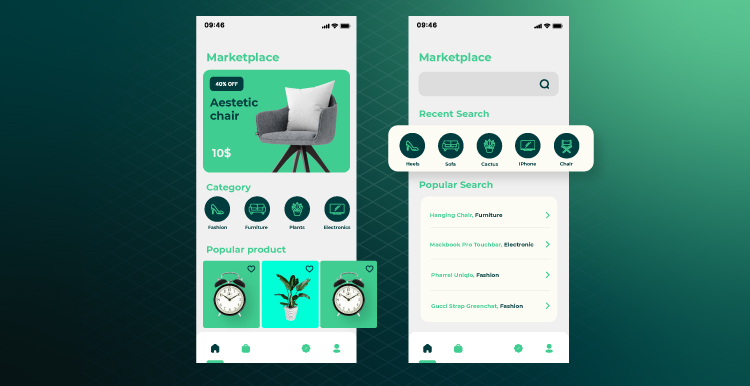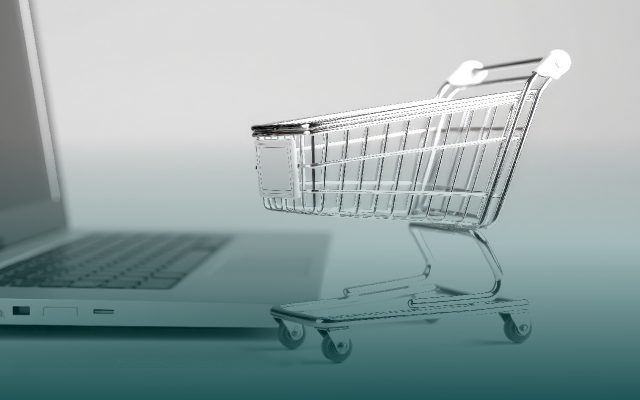Digital commerce is booming due to the acceleration of digitalization in the buyers’ changing habits and behaviors affected by the COVID-19 pandemic. Actually, marketplaces are the driving forces behind this transformation, especially in the era of millennials and GenZ preferring shopping on their smartphones. By 2024, the global mCommerce market is anticipated to reach $4,5 trillion which is equal to almost 70% of the total retail eCommerce sales.
So what is a mobile marketplace? How does mCommerce differ from the mobile marketplace? And why have digital marketplaces been the buzz during the last years? Why do brands need to develop strategies and participate in digital marketplaces? And finally, how to create your own mobile marketplace app to drive sales growth? All these questions and even more are covered in the following sections. Keep on reading.
What Is a Mobile Marketplace? Specifics and Principles
A mobile marketplace is an online mobile-oriented platform the purpose of which is to integrate the efforts of various vendors into one hub allowing them to sell products and services. Online marketplaces are positioned as distribution channels that are geared to help sellers and brands acquire new customers. When we are talking about the mobile marketplace, it means that this app is specifically designed for mobile devices focusing on user-friendly UI/UX. As opposed to independent eCommerce apps such as IKEA or Nike, digital marketplaces are integrated into the mutual system where products/services are delivered by multiple third parties.
It is of high importance to create a differentiated value proposition both for sellers and consumers. That’s why online marketplaces have to provide more value-added service offerings to sellers to enhance their competitive edge. Also, one of the forces that fuel digital marketplace acceleration is shifting market dynamics where customers expect personalization which, in turn, impacts the emergence of more niche-oriented and consumer-specific marketplaces. All these trends have to be considered when starting to build your marketplace app.
How Do Marketplaces Make Money? Business Models
While having an understanding of the specifics of the marketplace for sellers (gaining opportunities to woo more buyers) and buyers (reduced prices and a vast selection of products), you may wonder what profit you will gain when kicking off your mobile marketplace application. Let us help sort things out. Such big players as Amazon and Alibaba sell about $2 trillion in third-party products a year. Charging sellers for different actions on the platform impacts the generation of sizeable profits. But what is the best way to earn money in this niche? There is no all-in-one recipe — you can elaborate upon strategy combining different financial business models:
- Commission for transactions. As the most common business model, the commission is charged only for successful orders and depends on the value and number of transactions, which makes this model flexible and clear. Among the marketplace owners with this model type are eBay, Amazon, and Airbnb.
- Subscription fee. Subscription-based model charges upfront monthly or annual fees on a regular basis, which means sellers have to incentivize buyers to cover membership subscription fees. This model type is prevalent in learning and dating platforms.
- The listing model offers an equal and transparent payment option charging fees for listing products or services.
- The commission per lead. Such type of business model is somewhat between the commission model and listing fee and provides a better value proposition since a seller is charged when there is an interaction or connection with a customer.
- Freemium includes enhanced seller services with additional beneficial paid features.
What Are the Types of Mobile Marketplace Apps?
There are different types of marketplace applications based on such criteria as niche focus, target audience, offering type, and marketing business model (see above).
- Niche focus. Specific types of products/services belong to vertical marketplaces, while horizontal ones are focused on providing offerings from different industries.
- Offering type. The classification according to this criterion is conducted by types of products offered: goods, services, hybrid (goods and services), and fundraising. Each offering type has its specific features that need to be elaborated profoundly. For instance, if you build a service marketplace, your must-have features are the shopping cart and shipping integration.
- Target audience. The market cooperation model is divided into B2B, B2C, and C2C.
Why Do You Need to Build a Custom Mobile Marketplace App?
- Great access and visibility. One of the primary benefits of marketplace apps is the approach applied while developing the marketing strategy: both sellers and buyers are at the forefront of gaining these advantages. The “all-in-one” approach gives sellers the opportunity to ensure great access and visibility to their products without additional marketing efforts. And customers, in turn, can satisfy their buying needs in one place diving into the diversity of choices.
- Profit and margin growth. Online sales infrastructure nullifies the cost of physical ones, allowing to increase in profits and margins significantly. Being mobile-oriented, the marketplace a priori has a seamless and user-friendly user interface that facilitates a better and flawless customer experience.
- Increased marketability. Regardless of the business size, companies are listed on the playing field with similar marketing and sales strategies, which allows small businesses to compete with big players and acquire new customers through personalization and recommendation features.
How to Build Marketplace App: Guidelines and Best Practices
1. Market research and vision ideation
This initial phase in product development is a fundamental step toward further business growth. Without proper market research and assessing your potential customers’ behavioral patterns, preferences, and socioeconomic peculiarities, your idea may turn out to be failed in the early phases of development. Therefore, in this stage, define users’ needs, detect potential bottlenecks, identify pain points, compare competitors’ offers and how they attract new customers, identify channels of distribution, etc.
Once you figured out user activity in your marketplace, it will be easier for you to choose the type of marketplace you are going to launch. With this purpose, start creating user journeys to get actionable insights into how your buyers and sellers will interact with your app.
2. Choose the right tech stack
To create a fully functional app, it is of high importance to select appropriate languages, frameworks, databases, servers, and API integrations. The selection depends on the plethora of requirements: particular needs of the app, users’ preferences, product requirements, budget, and individual approaches and methods used by software engineers.
Basically, you have to define the languages and frameworks you will use for back-end and front-end operations. The most popular languages are Java, PHP, Python, and Ruby. Java, for example, has great performance and is perfect for debugging. Ruby is great for eCommerce applications since it enables the implementation of complex features and integrations. However, in comparison with Java and Python, it is slower. Being a top programming language, Python allows for building flexible and versatile apps with high intuition and dynamics. Moreover, its compatibility with all databases makes Python stand out on the market. Our top-notch marketplace app developers can help you decide on the best tech stack tailored specifically to your project goal.
3. Create structure and app layout
At this stage, software architectures and product designers are involved in the process to ensure comfortable UX and navigation both for customers and sellers. To define what structure your app will have, you have to determine the functionality of the app based on the target audience and presumptions on how they will behave on the platform. Also, the structure depends on the type of your marketplace. Designers create mock-ups with regard to mobile-friendly navigation and intuitive shopping experience.
4. Define marketplace features
The determination of the feature lists depends on the unique requirements of your potential audience and the type of your marketplace. Features you will come up with have to correspond to the user’s behavioral patterns. As we mentioned before, mapping out user journey steps will give you a guide to what features to outline in the app. Also, building a minimum viable product will help you attract early customers and check out the feasibility and relevance of features.
What Are the Essential Features of the Marketplace App?
To start elaboration upon the marketplace app, you have to consider user roles, which will require the creation of the buyer panel, seller panel, and administrative panel. Let’s have a brief look at the categories and features each panel should contain.

- Onboarding. Everything begins with the onboarding process via sign-ups and creating a personal profile covering personal information, favorite items, order history, and payment method. Afterward, come up with ideas on how to organize email integration and user profile settings so that the buyers can set up personalized notifications and change their personal information. The structure of your app will define the profile creation options. For example, you can develop an app with two different user roles, allowing the user to choose the appropriate profile: seller or buyer. Or you can combine both in one account.
- Listing management. As the core of the app, the listing feature provides product descriptions that have to be unbiased, informative, and buyer-friendly. To increase conversion rates display discounts and coupons, honest reviews and ratings, and take care of the demonstrative side of the page by adding fast-loading videos and photos.
- Categories. Service categorization is a must-do to optimize customer experience and navigation.
- Transaction management. This feature has to cover all the financial details of the completed transaction (billing, taxes, transaction status, etc.).
- Checkout process. To ensure a successful checkout process, it is of high priority to provide a user with fast payment processing and offer several reliable payment getaways. During this process, avoid pop-up windows, ads, and other distractive maneuvers. This will help prevent a user from shopping cart abandonment. Once the purchase is performed, offer recommendations tailored to the customer’s preferences and based on the history of orders and searches.
- Stock and order management. Both sellers and buyers must have the functionality to track the order status and delivery with such details as payment details, product descriptions, saved addresses, wishlist items, shipping and delivery notifications, etc. Ensure a trustworthy delivery service is integrated into your app.
- Third-party integrations. Integrating your marketplace with your CRM, ERP, and other sales and marketing tools will foster the tracking process and overall business performance.
- Reports and Analytics. Sellers must have the possibility to have all the statistics about product views, purchases, and the number of product items that were favored by buyers. Moreover, in order to analyze the sales progress, sellers have to be able to view business performance represented on the user-friendly dashboards providing such details as revenue, total earnings, sold products, top selling products, traffic, users’ activity, and much more.
What Can Be the Challenges When Building the Marketplace App?
To start developing your marketplace app, you have to define bottlenecks along the way and explore unpredictable e-commerce challenges you may deal with. So that you can be equipped with the right solutions to eliminate adverse effects.
- Fraudulent sellers who sell counterfeit products or deceive customers by not sending the product or requesting chargebacks are some of the biggest problems of digital marketplaces. To avoid fraud schemes in your marketplace, you have to think of fraud-detecting software in advance.
- A lot of issues are the reason for the half-baked strategy of logistics and delivery services cooperation. Your buyers want to track their parcels in real-time and be able to select options for delivery as well as be ensured the possibility of return or replacement in case the product did not fit.
- Complex checkout process. The multi-stepped ordering procedure suppresses the buyer’s desire to proceed with the purchase. Therefore, one-click checkout has to be your must-have feature along with offering multiple payment options and a seamless user experience.
So How to Get Started?
Once you decide what type of marketplace you want to build, it’s time to conduct profound research on your competitors and define your target audience, and identify their pain points. Deciding on your monetization method is equally important. Once you define your business goal and come up with the vision of the marketplace app, you can proceed with selecting the professional software engineering team to facilitate your idea, translating it into an actionable technical project.
If you need more details on the product development and budget, contact us and we will discuss your project with consideration of your requirements and expectations.

Our Engineers
Can Help
Are you ready to discover all benefits of running a business in the digital era?

Our Engineers
Can Help
Are you ready to discover all benefits of running a business in the digital era?







